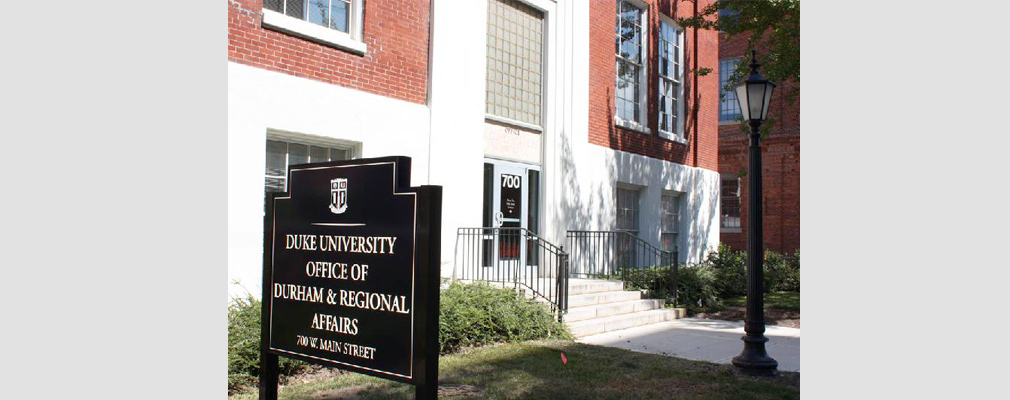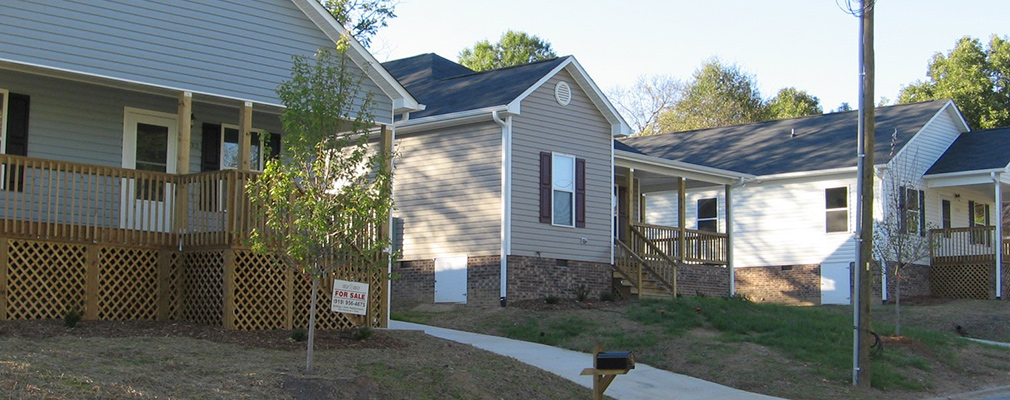Home >Case Studies >Duke University Joins Partners in the Durham Region
Duke University Joins Partners in the Durham Region
In her inaugural address as president of Duke University in 1993, Nannerl O. Keohane declared, “We must recognize the impact of what we do here on our neighbors, and on the quality of the society in which we live.” This understanding led the university to reach out to leaders of local public schools and residents of 12 Durham, North Carolina neighborhoods surrounding the campus to create a positive environment in which all stakeholders could work toward mutually beneficial community improvements. First through the Duke-Durham Neighborhood Partnership, and now also through the Office of Durham and Regional Affairs, the university is establishing partnerships to help neighborhoods across the region achieve their educational, housing, and community development goals. These activities include assistance with neighborhood efforts to improve educational outcomes, strengthen local organizations important to residents, and develop safe and affordable housing options. Duke’s work with the community has been recognized nationally on the President's Higher Education Community Service Honor Roll for 2014 in the categories of Education and Economic Opportunity.
Improving Local Partnerships
In 1994, to become more involved in the socioeconomic success of Durham, Duke provided an interest-free loan to the local Self-Help Credit Union, which used the money to finance affordable housing development in the Walltown neighborhood. Over the next seven years, Duke increased its loan to a total of $8 million, so that the Credit Union could invest in more housing and other revitalization projects in additional areas throughout the region. In all of these endeavors, the university and the credit union partnered with numerous other local organizations to increase homeownership, reduce crime rates, and improve the physical condition and social cohesiveness of the participating neighborhoods.
Duke’s efforts to improve communications with its neighbors, as well as its investments in affordable housing, helped the community change its perception of the university as embodying “institutional arrogance and isolation” and fostered an environment of mutual trust and respect, according to Sam Miglarese, director of the Duke-Durham Neighborhood Partnership. The Neighborhood Partnership, founded in 1996 to institutionalize Duke’s goals for community engagement, provided an avenue for the university to better assist its partners. The new entity also symbolized to the community and to all departments of the university a lasting commitment to collaboration with the community. Duke’s efforts at engagement received a boost in 1997, when it was awarded a HUD Community Outreach Partnership Centers (COPC) grant for work in Southwest Central Durham. Through the grant-funded work, the university learned important lessons about cooperating with local stakeholders, a turning point at which Duke and its neighborhood partners learned “to think more broadly about how we could work together,” according to Mayme Webb-Bledsoe, senior neighborhood coordinator with the Duke-Durham Neighborhood Partnership.
The Duke-Durham Neighborhood Partnership and the COPC process helped foster trusting and collaborative partnerships that continue to address issues in Durham. According to Miglarese, “People really appreciated the new vision but kept saying that Duke needed to do more.” In response, Duke created the Office of Durham and Regional Affairs in 2008 and, at the same time, established a vice presidency in the university administration to emphasize the importance of the region’s well-being to the institution’s success. The new office, with its regional purview, has enabled Duke to join in partnerships that address issues concerning Durham County residents, 20 percent of whom live below the federal poverty level.
Continuing Partnerships
Now housed in the Office of Durham and Regional Affairs, the Duke-Durham Neighborhood Partnership is integral to the office’s community development efforts at the local level. The Neighborhood Partnership also participates in numerous continuing initiatives, including the Southwest Central Durham Quality of Life Project, which started in 2001 and addresses housing, economic development, cultural enrichment, and the sustainability of nonprofit organizations in six neighborhoods adjacent to the university. Since the project’s launch, the Neighborhood Partnership has facilitated the community’s planning processes and helped implement some of the plans’ action items, which most recently have led to improved safety and access to parks.
A current activity of the Quality of Life Project is the development of the West Chapel Hill Street commercial corridor, an arterial street connecting the university to Durham’s central business district. Revitalization efforts along this corridor include sidewalk and landscaping improvements, a bike path, and a combined retail and office development. Emphasizing the importance of the community-driven process, Webb-Bledsoe observes, “They are the ones that formed the vision” for the revitalization of the corridor and who, through their implementation efforts, have been central to the project’s success thus far.
Investment and Development
Duke extended its community engagement to revitalization efforts in Downtown Durham by investing in the Durham Performing Arts Center. In addition, the university has located several administrative offices in the privately owned American Tobacco Campus; Duke’s pledge to be a major tenant early in the revitalization of the multiuse facilities fostered interest in the venture on the part of other potential tenants. The university is also participating in workforce development initiatives to ensure that residents of underserved neighborhoods are not excluded from the renaissance that is well underway in Durham’s commercial core. Framing Duke’s community engagement within a national trend among institutions of higher learning, Miglarese states, “There is no question that the university . . . is stepping out of the ivory tower and understanding [the] need to [be] part of the community in which it resides.” Such changes in university-community relationships enhance the university’s reputation with prospective students and faculty and fulfill its mission to serve the community. These changes also allow the university to grow and the community to benefit from that growth as Durham works on its own improvement programs.
Source:
Duke University Office of Durham and Regional Affairs. n.d. “Duke as a Neighbor, Investor and Financial Partner in Durham.” Accessed 11 March 2016; Group interview with Sam Miglarese, director of community engagement, Duke-Durham Neighborhood Partnership; Mayme Webb-Bledsoe, senior neighborhood coordinator, Duke-Durham Neighborhood Partnership; and Neil Hoefs, program coordinator, Duke-Durham Neighborhood Partnership, 3 March 2016; Jenny Carolina and Sam Miglarese. n.d. “Duke University Office of Durham and Regional Affairs.” Accessed 16 February 2016; Duke University Office of Durham and Regional Affairs. n.d. “Duke University Makes President’s Community Service Honor Roll.” Accessed 10 March 2016.
×Source:
Joint interview with Sam Miglarese, director of community engagement, Duke-Durham Neighborhood Partnership; Mayme Webb-Bledsoe, senior neighborhood coordinator, Duke-Durham Neighborhood Partnership; and Neil Hoefs, program coordinator, Duke-Durham Neighborhood Partnership, 3 March 2016; Jenny Carolina and Sam Miglarese. n.d. “Duke University Office of Durham and Regional Affairs.” Accessed 16 February 2016; Documents provided by Sam Miglarese.
×Source:
Joint interview with Sam Miglarese, Mayme Webb-Bledsoe, and Neil Hoefs, program coordinator, Duke-Durham Neighborhood Partnership, 3 March 2016; Documents provided by Sam Miglarese.
×Source:
Joint interview with Sam Miglarese, Mayme Webb-Bledsoe, and Neil Hoefs, program coordinator, Duke-Durham Neighborhood Partnership, 3 March 2016; Documents provided by Sam Miglarese; Partnership for a Healthy Durham. 2014. “Durham County: 2013 State of the County Health Report.”
×Source:
Joint interview with Sam Miglarese, Mayme Webb-Bledsoe, and Neil Hoefs, program coordinator, Duke-Durham Neighborhood Partnership, 3 March 2016; Documents provided by Sam Miglarese.
×Source:
Duke University Office of Durham and Regional Affairs. n.d. “Our Five-Year Report to the Community.” Accessed 10 March 2016.
×Source:
Joint interview with Sam Miglarese, Mayme Webb-Bledsoe, and Neil Hoefs, program coordinator, Duke-Durham Neighborhood Partnership, 3 March 2016; Documents provided by Sam Miglarese.
×Anchor Institutions
- U.S. Virgin Islands Nonprofit Helps Community Focus on Disaster Recovery and Resiliency
- A Model for Community-Based Policing in Pittsburgh
- Click here for more
Community Development
- Repurposing a Historic Mill for Affordable Housing in a Growing Community
- Avalon Villas Combines Affordable Housing and Services for Families in a Gentrifying Phoenix Neighborhood
- Click here for more
Senior Housing
- Former School in Charleston, South Carolina, Transformed into Affordable Housing for Seniors
- Richmond, California: Rehabilitation of Vacant Public Housing Site Preserves Senior Housing
- Click here for more
Supportive Housing
- Yakima, Washington: An Adaptive Reuse Project Provides Supportive Housing for Formerly Homeless Veterans
- Village on Mercy Provides Supportive Housing in Orlando, Florida
- Click here for more
Sustainable Housing
- Pacific Landing Provides Energy-Efficient Affordable Housing in Santa Monica, California
- Innovative Solar Technology Powers Affordable Housing in River Falls, Wisconsin
- Click here for more
Zoning for Affordable Housing
The contents of this article are the views of the author(s) and do not necessarily reflect the views or policies of the U.S. Department of Housing and Urban Development or the U.S. Government.



